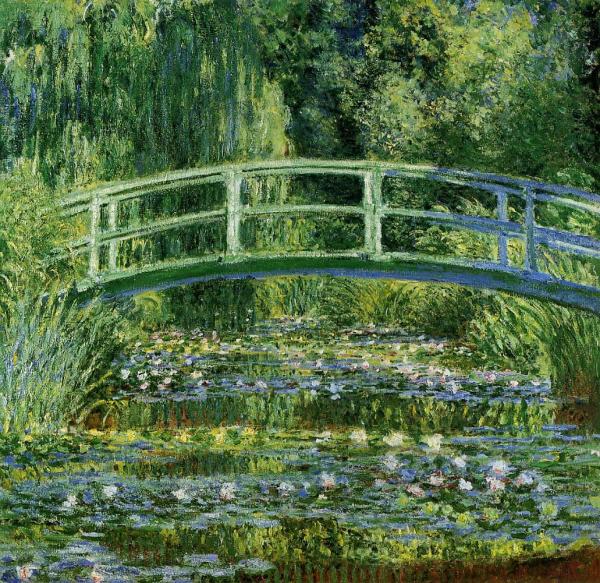![[IMAGE of a Monet Painting]](http://krypton.mnsu.edu/~schumann/www/images/monet_s2.jpg) |
| Gare St-Lazare, 1877 |
The journey into Claude Monet's world in the 1870s should start with the Gare Saint-Lazare. Anyone who is visiting Monet's house and garden in Giverny by train will come through this station situated in the northwestern part of Paris.
The development of the Gare Saint-Lazare and its vicinity at the time attracted many artists who found in the modern environment of the train station an appropriate setting for their exploration of new pictorial forms. Monet painted this scene many times, as did Edouard Manet. What makes better subject matter for the Impressionists than the fleeting lights of a cityscape or a train station.
 |
| Monet's house in Giverny |
Monet lived in Giverny for more than 40 years and created some of his most celebrated pictures, such as his Water Lily and Japanese Bridge, based on the direct observation of his surroundings.
 |
| Monet's studio-sitting room |
His studio-sitting room on the ground floor of the house also served as a gallery to display his work as well as a place to entertain his friends. Notice how different paintings were hung at that time. The tiered configuration was modelled after the exhibitions held at the Salon where young and established artists alike sought to show their work. On the first floor are the private apartments that overlook the garden.
 |
| Prints depicting foreign merchants |
It is a well-known fact that Japanese art became very popular in France particularly towards the mid 19th century and Ukiyo-e woodblock prints were widely collected by French artists. Walking through Monet's house is a testimony to the artist's obsession with Japanese art. There is not a single wall or an empty space that is not covered with masterpieces from Edo Japan. His remarkable collection of Japanese prints features some of the most representative works by prominent artists of the period - Utamaro, Hokusai and Hiroshige plus others that amounts to 243 pieces in total. Monet took a special interest in landscapes, courtesans and scenes depicting foreign merchants.
 |
| Monet's bedroom shows imageries of courtesans |
It may take a leap of imagination to explain how Japanese prints reached the West. Believe it or not, they were used as packing material for trade goods. By the Meiji period (1868), the introduction of photography in Japan directly led to the demise of Ukiyo-e as an art form. They became so out of fashion that they were worthless. But as these prints made their way to Europe, they became a major source of inspiration for the Impressionists and the influence is termed Japonisme.
 |
| The dining room is filled with Monet's prized Japanese prints |
Monet's passion for Japanese art did not stop with woodblock prints. The inspiration he drew from the Japanese art of gardens is clearly visible in the planning of the pond which he transformed into a spectacular water garden. The footbridge spanning this stretch of flower-covered water is reminiscent of the Japanese bridges omnipresent in Ukiyo-e imageries.
 |
| Man on horseback crossing the bridge, Hiroshige, 1834-1842 |
 |
| The Water Lily Pond, 1899 |
 |
| The water-lily pond as it is today |
During the last thirty years of his life, Monet worked on "series" paintings, in which a subject was depicted in varying light and weather conditions. Increasingly, his garden at Giverny became his most painted subject and his series of
Water Lilies totalled approximately 250 paintings. Some of his murals are massive works. For instance, the
Water Lilies in Musee L'Orangerie measures 2 m x 6 m.
 |
| Monet at work in his studio |
 |
| A view of the lily-pond |
In a way, visiting Monet's garden was like reliving the moments when the artist put his brush to canvas. The first stroke that defined the composition was followed by the gradual emergence of an impression of light, reflections and colours as Monet had envisioned.
![[IMAGE of a Monet Painting]](http://krypton.mnsu.edu/~schumann/www/images/monet_s2.jpg)










Monet Prints Large selection of Canvas art, giclee and canvas prints for a cheap price. Our Art is Better than GOOD.
ReplyDeleteGreat post, and great website. Thanks for the information! 5 STEPS PLAN ON HOW TO BECOME FINANCIALLY INDEPENDENT
ReplyDelete